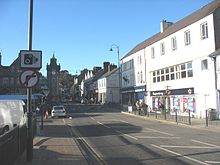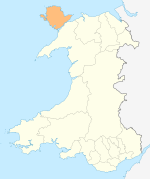Human settlement in Wales
| Llangefni | |
|---|---|
 Llangefni clock tower Llangefni clock tower | |
 | |
| Population | 5,116 2011 Census |
| OS grid reference | SH4675 |
| Principal area | |
| Preserved county | |
| Country | Wales |
| Sovereign state | United Kingdom |
| Post town | Llangefni |
| Postcode district | LL77 |
| Dialling code | 01248 |
| Police | North Wales |
| Fire | North Wales |
| Ambulance | Welsh |
| UK Parliament | |
| Senedd Cymru – Welsh Parliament | |
|
53°15′22″N 4°18′50″W / 53.256°N 4.314°W / 53.256; -4.314  Map of the community | |
Llangefni (Welsh for 'church on the river Cefni'; Welsh pronunciation: [ɬaŋˈɡɛvni]) is the county town of Anglesey in Wales. At the 2011 census, Llangefni's population was 5,116, making it the second-largest town in the county and the largest on the island. The community includes the village of Rhosmeirch.
Location
The town is near the centre of Anglesey, and is on the River Cefni, after which it is named. Its attractions include the Oriel Ynys Môn museum, which details the history of Anglesey and houses collections of the painters Kyffin Williams and Charles Tunnicliffe. In the west of the town is a large secondary school, Ysgol Gyfun Llangefni (Llangefni Comprehensive School), and in the north a Victorian parish church, St Cyngar's, set in a wooded riverside location called the Dingle. The town was formerly named Llangyngar, Welsh for "St Cyngar's church".
Commerce, transport and education



Llangefni is a commercial and farming town in Anglesey and once hosted the largest cattle market on the island. There is a relatively large industrial estate, which included a large chicken processing plant, the largest single industrial operation in the town, until March 2023 when it closed with the loss of 700 jobs. Several other smaller businesses remain.
The town had a station on the Anglesey Central Railway line which opened in 1864. It closed in 1964, although goods trains continued to pass through the town until 1993. Since then, there have been proposals to convert the line into a multi-purpose path at a cost estimated at £10 million pounds. Although no longer usable, the railway tracks have not been removed. The route remains under the control of Network Rail, leased to Anglesey Central Railway (2006) Ltd, which hopes to raise some £150 million to reinstate a working railway. Hybrid plans also exist for a cycle route along 16 miles (26 km) of the line (the majority of its length), which would also allow the route to be used for a heritage railway. The nearest station is now at Llanfairpwllgwyngyll, 5 miles (8 km) away as the crow flies. There are frequent buses to the larger settlements of Bangor and Holyhead as well as to the smaller towns of Amlwch and Beaumaris. By road the town is just 2 kilometres from the major A55 and A5 roads, via the short A5114. Water for the town comes from Llyn Cefni, a reservoir 1.5 miles (2.4 km) to the northwest.
Llangefni hosted the National Eisteddfod in 1957 and 1983, and in 1999 gave its name to the Eisteddfod held at the nearby village of Llanbedrgoch. It also hosted the Urdd Eisteddfod (youth Eisteddfod) in 2004. The town also has a college, Coleg Menai (Llangefni site).
Llangefni is home to the headquarters of large builders merchant chain Huws Gray. The company currently has over 100 branches across the UK.
Sport
The local association football club, Llangefni Town, was promoted to the Welsh Premier League at the end of the 2006–07 season, but relegated one season later.
The local rugby club is Llangefni RFC, which plays in the WRU leagues. The club recently gained promotion to Division 2 West, but the WRU then decided to demote the club back to Division 4 North Wales league.
Welsh language skills
According to the 2011 Census, Llangefni is the community with the highest percentage of Welsh speakers on the Isle of Anglesey, and the 6th highest in Wales. 80.7% of residents aged three and over reported being able to speak Welsh in the 2011 Census, as compared to 83.8% reporting being able to do so in the 2001 Census. 91.6% of those born in Wales could speak Welsh.
Governance

There are two tiers of local government covering Llangefni, at community (town) and county level: Llangefni Town Council and Isle of Anglesey County Council. The town council is based at the former courthouse on Glanhwfa Road.
Administrative history
Llangefni was an ancient parish. In 1890 the parish was made a local government district, administered by an elected local board. Such local government districts were reconstituted as urban districts under the Local Government Act 1894.
Llangefni Urban District was abolished in 1974, with its area instead becoming a community. District-level functions passed to Ynys Môn-Isle of Anglesey Borough Council, which in 1996 was reconstituted as a county council.
The original Anglesey County Council was based at Llangefni Shire Hall from 1899 until 1974. The shire hall was re-designated the "Borough Council Offices" in 1974 and became the headquarters of Ynys Môn-Isle of Anglesey Borough Council. New council offices were built on Mill Street (Welsh: Lon-y-Felin) in Llangefni in the late 1990s for the new Isle of Anglesey County Council.
Notable people
- John Elias (1774–1841), preacher, lived in the town 1830–41
- Christmas Evans (1766–1838), preacher and chapel builder, lived in the town 1791–1826
- Gabriel Fielding (1916–1986), author, attended Llangefni County School, in 1934
- Huw Garmon (born 1966), a Welsh actor
- Nathan Gill (born 1973), politician, former Leader of Reform UK Wales; lives in Llangefni
- Hugh Griffith (1912–1980), Oscar‑winning actor, attended Llangefni County School in his youth
- Hywel Gwynfryn (born 1942), television and radio personality, studied at Ysgol Gyfun Llangefni
- Myfanwy Howell (1903–1988), Welsh language radio and television broadcaster
- Naomi Watts (born 1968), Oscar‑nominated actress, lived in the town between the ages of 7 and 10
- Kyffin Williams (1918–2006), Welsh landscape painter
References
- ^ "Area: Llangefni (Parish) Key Figures for 2011 Census: Key Statistics". Neighbourhood Statistics. Office for National Statistics. Retrieved 19 June 2011.
- Mills, A. D. (2003). A Dictionary of British Place-Names. Oxford: Oxford University Press. ISBN 9780198527589.
- Davies, John; Jenkins, Nigel; Baines, Menna; Llynch, Peredur (2008). The Welsh Academy Encyclopaedia of Wales. Cardiff: University of Wales Press. p. 494. ISBN 978-0-7083-1953-6.
- BBC News. 2 Sisters: 700 jobs go as Anglesey chicken plant shuts. 31 March 2023 https://www.bbc.co.uk/news/uk-wales-65127304
- "Plans revealed for £2million walk and cycle route in Ynys Môn". Sustrans. 5 March 2009. Archived from the original on 27 March 2009. Retrieved 8 March 2009.
- "About Us". HuwsGray.co.uk.
- "Llangefni fight WRU 'relegation'". BBC News. 18 May 2007. Retrieved 20 August 2007.
- "2011 Census results by Community". Welsh Language Commissioner. Archived from the original on 14 September 2017. Retrieved 9 April 2016.
- "Llangefni Town Council". Retrieved 1 November 2024.
- "Llangefni Ancient Parish / Civil Parish". A Vision of Britain through Time. GB Historical GIS / University of Portsmouth. Retrieved 1 November 2024.
- Annual Report of the Local Government Board. H.M. Stationery Office. 1891. p. 449. Retrieved 1 November 2024.
- "Llangefni Urban District Council Records". Jisc Archives Hub. Anglesey Archives. Retrieved 1 November 2024.
- Local Government Act 1972
- Local Government (Wales) Act 1994
- "Anglesey's Shire Hall could be transformed into pod hotel and business centre". North Wales Live. 5 November 2019. Retrieved 22 October 2021.
- "No. 48503". The London Gazette. 23 January 1981. p. 1089.
- "Isle of Anglesey Borough Council". Retrieved 22 October 2021.
- Jones, Geraint; Rowlinson, Gwenllian Jones (2015). "Llangefni". Anglesey Towns & Villages (Internet ed.). Amberley Publishing. ISBN 978-1445651538. Retrieved 2 January 2021.
